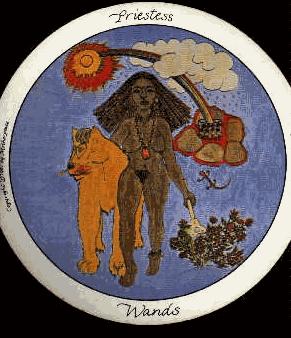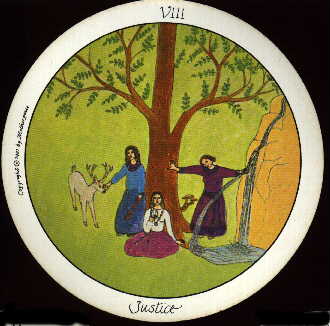



Motherpeace—Book & Tarot
Images by Vicki Noble & Karen Vogel
Book by Vicki Noble
Published by Harper and Row, 1983
Vicki Noble makes no bones about her bias. Her book Motherpeace was first published in the early 80's as the companion to the Motherpeace Tarot deck, and it begins, "Patriarchy has brought us no peace." Well. Notwithstanding the arguably obvious fact that such simplistic reductionism is suitable only for simpletons, Vicki Noble uses this as her springboard for not only celebrating the Goddess, but for demonizing and rejecting the "God." The result is a deck that is at best imbalanced, and at worst, overtly exclusionary in precisely the way that Noble claims to condemn. She calls her work "visionary," but it's a vision that hasn't aged well.
The deck is round—an interesting break from convention and "male" angularity. The authors of the deck use color well—despite the simplicity of the art, the cards are aesthetically pleasing, for the most part. Many cards have been changed to reflect the authors’ feminist philosophy—the Hermit has become the Crone, the Hanged Man has become the Hanged One, and so on. The deck does away with the violent imagery found in the Rider-Waite deck.
The deck’s images depict people—mostly women—from diverse ethnic backgrounds. The scenes depicted, and the art depicting them, are primitive—deliberately, says Noble, in the book. The images reflect the "prepatriarchal era . . . When the mother-centered group was alive." This atavism may explain the deck’s preoccupation with nudity: 41 cards depict nude or partially nude women, and of those 41 cards, about a third depict full frontal nudity, often with the female figure’s legs spread-eagled. "Breasts," Noble writes, "are the symbol par excellence of Mother-love . . ." The images are not sexual or offensive, really—they just become tedious, and silly, the same way a deck full of penises (whatever they might be the symbol par excellence of) would become tedious and silly. Breasts, genitals, breasts, genitals, breasts, genitals--Okay, already, we get it!
The book & deck are unintentionally funny in places. The Emperor depicts "Alexander ‘the Great’ " with breasts, amusing enough without the author qualifying his greatness with quotation marks. The Empress—the previous card—is celebrated for pages. The Emperor is scorned and mocked for pages, for he embodies Patriarchy, and, the author assures us, "The overriding characteristic of patriarchal culture is that female control over birth and sexuality is brought to an end, the woman belongs to the patriarch, and the children bear their father’s name." Rape becomes institutionalized. Alexander "the Great" embodies these values. The author writes, "It was during Alexander’s reign that the great matriarchal libraries were burned to the ground, most thoroughly destroying ancient wisdom." In the card, Alexander "the Great" crosses his legs, denying his sexual feelings, and folds his arms across his chest, signifying his blocked emotions, or emotions dominated—killed—by ego. "A study in blocked emotions, he periodically erupts into aggression, war, anger, and oppression of those ‘beneath’ him. He is the epitome of the four-year-old child whose temper tantrums abound with the affirmations: ‘I, me, mine.’" In divination, the card means, "look out—you are up against an angry, patriarchal structure of some kind . . ."
In the Motherpeace deck, the Devil card no longer depicts a devil, but a Patriarch. Here is Noble’s own straight-faced description of the card:
At the top of the pyramidal structure so loved by Patriarchy is the Big Man, who may take the form of the Emperor . . . Next in line are his immediate subordinates, who maintain their status by doing his bidding. Preeminent in the picture is the exchange of gold between higher-ups. On the left, a mother on the lowest step is having to sacrifice her own child to the chain of command. On the right, soldiers guard the Big Man and fight off an Amazon who has broken her chains.
And so on. That which is negative & unholy in the world, is depicted in these cards as distinctly "male." That which is positive, sacred, and beautiful is female. (Females are incapable of corruption, deceit, oppression, apparently.) Male figures are positively represented in some of the court cards, but not insignificantly these male figures are divested of (neutered?) characteristically Male qualities quite as much as female figures in this deck are invested with characteristically Female qualities. The authors of the deck may see a necessary justice in this, a striking of balance beyond the deck, making up in some modest way for thousands of years of rape and oppression and unfortunate hierarchies. But the problem with this—and it will be a problem for the more even-tempered members of the tarot community—is that they make it seem as though Womanhood cannot be celebrated without Manhood being destroyed. The Motherpeace deck, despite its innovations, becomes another soapbox for the School of Resentment. This is the same old demon—only now the demon has breasts.
Review text Copyright 1999 by Webmaster. All rights reserved.
Motherpeace Images Copyright 1981 by Motherpeace. All rights reserved.